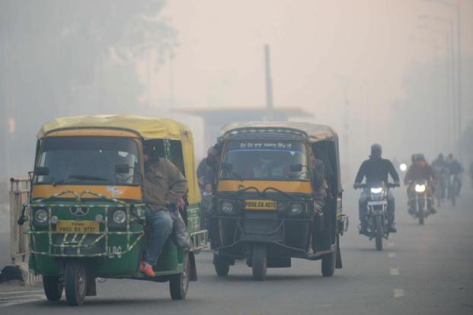
In mid-November, dangerously high levels of particulate matter pushed Delhi’s air quality index into the orange “very poor” air zone, throwing Delhi’s administration into panic, with talk of bringing back restrictions on private vehicles to combat the deadly air. Yet, through 2018, other cities in India experienced similar deadly dips in their air quality, relatively unnoticed: for instance, mid-February in Ahmedabad, through December in Hapur, late November in Gaya, the air quality should have warranted emergency measures in these cities.
As the New Year brings in both lethal air and hopes for greater action on air quality in North India, data for 2018 shows that several Indian cities had worse levels of air pollution in 2018 than the worst in the world. The good news, however, is that particulate matter (PM) levels have declined in most Indian cities for which data is available.
In 2016, the last year for which globally comparable data was available, the top 13 spots for the most polluted cities in the world were taken up by Indian cities, led by Kanpur, according to the World Health Organization’s (WHO’s) Ambient Air Quality Database.
While 2018 was a better year for air quality than 2016 and 2017, many of these cities would still make the global list in 2018, if trends in the rest of the world remained unchanged, an analysis of Central Pollution Control Board (CPCB) data shows.
Kanpur, the world’s most polluted city in 2016, registered a significant improvement in its particulate matter levels in 2018, as did the other Indian cities in the WHO list, including Delhi.
However, some of Delhi’s satellite cities for which data was not available in 2016 registered much higher air pollution levels in 2018 than Kanpur, Gaya or Delhi, creating a new “worst in the world” record.
The industrial hub of Bhiwadi in Rajasthan and Ghaziabad in Uttar Pradesh, both part of the National Capital Region (NCR), were not measured in 2016, but had among the highest levels of particulate matter in 2018. Gurugram was one of the few cities to get worse between 2016 and 2018.
While a range of pollutants found in the air have negative impacts on human health, this analysis focuses on the level of PM2.5 and PM10—tiny particles of less than 2.5 and 10 microns diameter, respectively.
These tiny particles are capable of penetrating the lungs and entering their bloodstream at high concentrations.
Chronic exposure to these particles contributes to the risk of developing cardiovascular and respiratory diseases, as well as of lung cancer, according to the WHO. The WHO considers exposure to PM2.5 concentrations of under 10 microgram per cubic metre annually, and under 25 microgram on average over an hour to be safe.
India’s colour-coded air quality index considers PM2.5 levels under 30 ug/m3 to be “good” and over 90 to be poor.
Among cities for which consistent data was available for 2018, four of the five worst cities in terms of PM2.5 concentration levels are in NCR: Faridabad (163.5), Ghaziabad (141.9), Gurugram (132.1), and Bhiwadi (127.5). Patna (117.7) and Muzaffarnagar (116.7) follow close behind.
While much of the media, policy and politics debate around air pollution focuses on Delhi, the problem is equally bad in Delhi’s satellites and even beyond.
The northern cities are particularly badly affected. Several cities in this belt—Gaya, Muzaffarpur, Patna, Varanasi, Jodhpur—apart from Delhi’s satellites had levels of PM2.5 concentration this year that would have put them among the 20 worst cities of the world in 2016.
Unsurprisingly, North India is also the epicentre of pollution-related ailments and deaths.
Last year, 1.2 million people lost their lives to pollution, according to research by the India State-Level Disease Burden Initiative published in The Lancet Planetary Health . The study estimated that the highest PM2.5 exposure level was in Delhi, followed by the other North Indian states of Uttar Pradesh, Bihar and Haryana.
One out of every seven deaths in India was attributable to air pollution, and air pollution lowered Indian life expectancy by 1.7 years, the study showed. Although there is some dispute over its relative share, vehicular pollutionis undoubtedly an important contributor to air pollution. Construction and stubble burning seem to be the other big culprits in the North Indian belt.
Delhi’s odd-even scheme to reduce vehicles on its roads may not have had much of an impact but a series of clear-air focussed policy initiatives may finally be having some effect, an analysis of long-run pollution trends based on satellite imagery showed .
Despite dangerously high levels of particulate matter in other cities, no city other than Delhi has taken government-level action on air pollution so far.
One reason may be that the scale of the problem in the rest of the country is much less understood than it is in Delhi. The capital alone has 38 functional monitoring stations, as many as 11 other states put together. In comparison, Mumbai, the next biggest city, has just one monitoring station. Moreover, there are serious collection and data integrity problems with the reported CPCB (Central Pollution Control Board) data, which perhaps mask the real extent of the country-wide bad air problem.
Posted on :
Jan 02, 2019